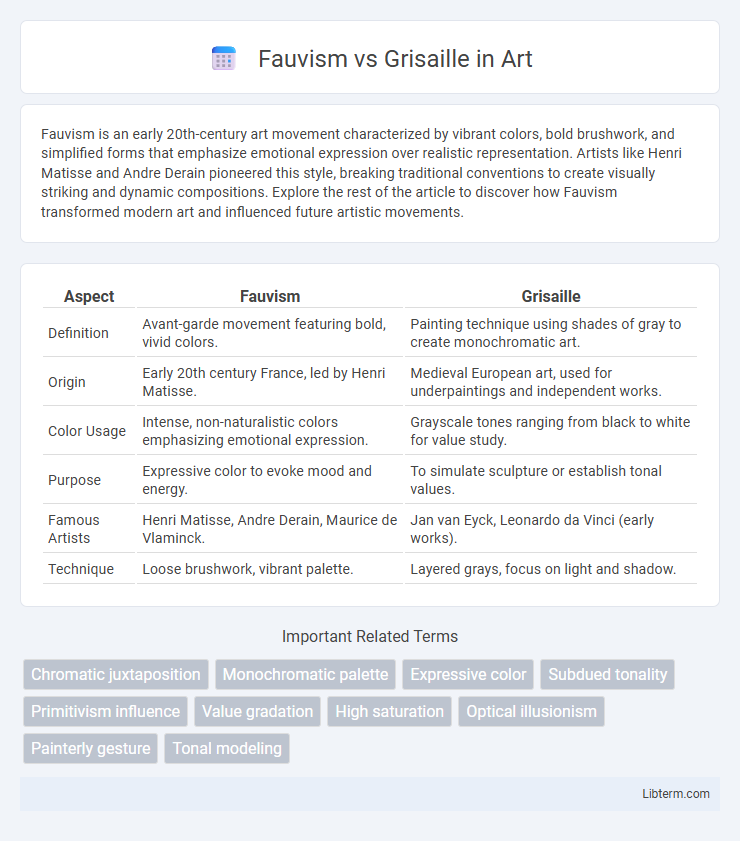Fauvism is an early 20th-century art movement characterized by vibrant colors, bold brushwork, and simplified forms that emphasize emotional expression over realistic representation. Artists like Henri Matisse and Andre Derain pioneered this style, breaking traditional conventions to create visually striking and dynamic compositions. Explore the rest of the article to discover how Fauvism transformed modern art and influenced future artistic movements.
Table of Comparison
| Aspect | Fauvism | Grisaille |
|---|---|---|
| Definition | Avant-garde movement featuring bold, vivid colors. | Painting technique using shades of gray to create monochromatic art. |
| Origin | Early 20th century France, led by Henri Matisse. | Medieval European art, used for underpaintings and independent works. |
| Color Usage | Intense, non-naturalistic colors emphasizing emotional expression. | Grayscale tones ranging from black to white for value study. |
| Purpose | Expressive color to evoke mood and energy. | To simulate sculpture or establish tonal values. |
| Famous Artists | Henri Matisse, Andre Derain, Maurice de Vlaminck. | Jan van Eyck, Leonardo da Vinci (early works). |
| Technique | Loose brushwork, vibrant palette. | Layered grays, focus on light and shadow. |
Introduction to Fauvism and Grisaille
Fauvism emerged in the early 20th century as a revolutionary art movement characterized by bold, vibrant colors and expressive brushwork, pioneered by artists like Henri Matisse and Andre Derain. In contrast, Grisaille is a monochromatic painting technique primarily using shades of gray to create a sculptural effect, often employed for underpainting or full compositions in Renaissance and Baroque art. Fauvism emphasizes color's emotional impact, while Grisaille focuses on form and tonal value without the use of color.
Historical Origins and Development
Fauvism originated in the early 20th century, led by artists like Henri Matisse who emphasized bold, non-naturalistic colors and spontaneous brushwork, marking a departure from traditional representation. Grisaille, with roots tracing back to medieval and Renaissance art, involves painting entirely in shades of gray to mimic sculpture or create tonal studies, serving as a foundational technique in European art history. While Fauvism embraced expressive color to evoke emotion, grisaille focused on form and value, reflecting distinct historical contexts and artistic objectives in their development.
Key Artists and Influences
Fauvism, pioneered by artists like Henri Matisse and Andre Derain, emphasized vivid colors and bold brushwork influenced by Post-Impressionism and African art. Grisaille, often used by Pablo Picasso during his Blue Period, focused on monochromatic painting in shades of gray, drawing inspiration from medieval sculpture and classical art traditions. Both movements reflect divergent approaches to form and color, with Fauvism pushing expressive color boundaries and Grisaille emphasizing tonal values and depth.
Core Principles and Techniques
Fauvism emphasizes vibrant, non-naturalistic colors and bold brushwork to convey emotional intensity, prioritizing painterly qualities over realistic representation. Grisaille relies on monochromatic tones, typically shades of gray, to create depth and form through careful modulation of light and shadow, often serving as an underpainting technique. Fauvist painters like Henri Matisse use exuberant color contrasts, while Grisaille artists focus on tonal variation to build three-dimensional illusions on a two-dimensional surface.
Use of Color: Vivid versus Monochrome
Fauvism is characterized by its use of vivid, non-naturalistic colors that emphasize emotional expression and bold contrasts, often employing bright reds, blues, and greens to create dynamic compositions. In contrast, Grisaille relies exclusively on monochrome shades of gray to mimic sculptural reliefs or create a subtle, tonal depth without color distractions. This technique emphasizes form, light, and shadow, offering a restrained and classical aesthetic compared to the extravagant chromatic palette of Fauvist works.
Thematic Focus and Subject Matter
Fauvism emphasizes bold, vibrant colors and emotional expression, often depicting landscapes, portraits, and everyday scenes with exaggerated hues to evoke mood. Grisaille centers on monochromatic shades of gray, focusing on form, texture, and volume, frequently used in preliminary sketches or finished works highlighting religious or classical themes. Thematic focus in Fauvism is driven by personal and emotional impact, while Grisaille prioritizes structural clarity and tonal modeling.
Fauvism’s Emotional Expression
Fauvism emphasizes bold, vibrant colors to evoke intense emotional expression, using exaggerated hues to convey raw feelings and dynamic energy. This style contrasts sharply with Grisaille, which relies on monochromatic tones of gray to create subtle, tonal depth and restraint rather than overt emotional impact. Fauvist artists prioritize color as a primary vehicle for emotional communication, making their works vivid and emotionally charged.
Grisaille’s Illusion of Sculpture
Grisaille is a painting technique that employs monochromatic shades of gray to create the illusion of three-dimensional sculpture on a flat surface, making it a popular method for mimicking stone reliefs and architectural decorations. Unlike Fauvism, which emphasizes bold, vibrant colors and expressive brushwork to evoke emotional intensity, Grisaille focuses on tonal modulation and precise shading to simulate depth and texture. The illusion of sculpture in Grisaille relies on careful visual cues such as highlights and shadows, enabling artists to create lifelike representations that convincingly replicate the solidity and form of carved stone.
Impact on Modern Art Movements
Fauvism revolutionized modern art by emphasizing bold, vibrant colors and emotional expression, influencing movements such as Expressionism and Abstract Art. Grisaille, characterized by monochromatic gray tones, contributed to the development of tonal studies and minimalist aesthetics, impacting movements like Minimalism and Photorealism. Both techniques reshaped visual perception, guiding artists toward innovative explorations of color, form, and light in 20th-century art.
Contemporary Relevance and Legacy
Fauvism's vibrant color palette and bold brushwork continue to influence contemporary abstract and expressionist artists, emphasizing emotional intensity over realistic representation. Grisaille, with its monochromatic technique often used for underpainting or mimicking sculpture, persists in modern digital art and design, highlighting form and contrast through shades of gray. Both techniques shape today's visual culture by inspiring innovative approaches to color theory and tonal study in artistic practices and education.
Fauvism Infographic

 libterm.com
libterm.com